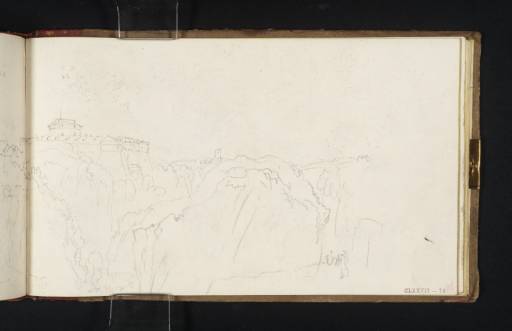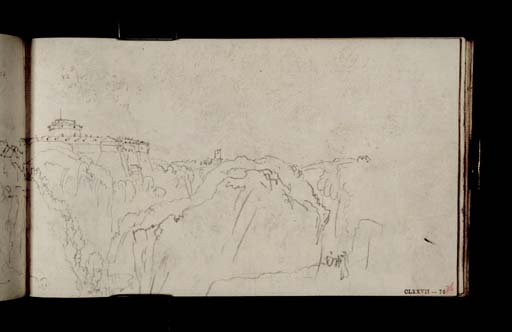Joseph Mallord William Turner Civita Castellana, from the Ponte Clementino 1819
Image 1 of 2
Joseph Mallord William Turner,
Civita Castellana, from the Ponte Clementino
1819
Joseph Mallord William Turner 1775–1851
Folio 76 Recto:
Civita Castellana, from the Ponte Clementino 1819
D14801
Turner Bequest CLXXVII 76
Turner Bequest CLXXVII 76
Pencil on white wove paper, 110 x 186 mm
Inscribed by the artist in pencil ‘[...]’ bottom right of sketch
Inscribed by John Ruskin in red ink ‘76’ bottom right
Stamped in black ‘CLXXVII 76’ bottom right
Inscribed by the artist in pencil ‘[...]’ bottom right of sketch
Inscribed by John Ruskin in red ink ‘76’ bottom right
Stamped in black ‘CLXXVII 76’ bottom right
Accepted by the nation as part of the Turner Bequest 1856
References
1909
A.J. Finberg, A Complete Inventory of the Drawings of the Turner Bequest, London 1909, vol.I, p.523, as ‘Civita Castellana’.
1984
Cecilia Powell, ‘Turner on Classic Ground: His Visits to Central and Southern Italy and Related Paintings and Drawings’, unpublished Ph.D thesis, Courtauld Institute of Art, University of London 1984, pp. 101, 469 note 143.
1987
Cecilia Powell, Turner in the South: Rome, Naples, Florence, New Haven and London 1987, p.34.
2008
James Hamilton, Nicola Moorby, Christopher Baker and others, Turner e l’Italia, exhibition catalogue, Palazzo dei Diamanti, Ferrara 2008, pp.44, 90 note 29.
2009
James Hamilton, Nicola Moorby, Christopher Baker and others, Turner & Italy, exhibition catalogue, National Galleries of Scotland, Edinburgh 2009, pp.42, 150–1 note 29.
The town of Civita Castellana lies in the Viterbo province of Lazio, approximately seventeen miles south of Narni and thirty miles north of Rome. It is approached from the north via the Ponte Clementino, a bridge built in 1712 which spans the deep gorge above which the town is built. This sketch depicts the view from the northern end of the bridge, looking across the ravine towards the town on the opposite side. The panorama continues on the opposite sheet of the double-page spread, see folio 75 verso (D14800). The distinctive building on this side of the panorama is the Forte Sangallo, a Renaissance construction named after the architect Antonio da Sangallo the Elder. This sandstone and brick fortress was built on high ground and is also known as the Rocca dei Borgia, after Rodrigo Borgia, the future Pope Alexander VI, who commissioned the conversion of the existing castle into the imposing fortress. It comprises an octagonal tower or citadel within a pentagonal fortress. In the nineteenth century, the building was used as a prison, earning it the name of the ‘Bastille of the Popes’. For a further sketch see folio 68 verso (D14786).
Perhaps the most famous feature in Civita Castellana was the gorge itself. With its dramatic rock formations and verdant foliage it presented an appealing subject for artists and was most famously depicted by the early French en plein-air artists such as Jean-Joseph-Xavier Bidauld (1758–1846), 1 Pierre-Henri de Valenciennes (1750–1819) and Jean-Baptiste-Camille Corot (1796–1875).2 Other sketches by Turner related to Civita Castellana can be found on folios 68 verso (D14786), 76 verso–78 (D14802–5) and 79–79 verso (D14807–8).
Nicola Moorby
November 2008
See Philip Conisbee, Sarah Faunce and Jeremy Strick, In the Light of Italy: Corot and Early Open-Air Painting, exhibition catalogue, National Gallery of Art, Washington 1996, p.141 and Anna Ottani Cavina, Un Paese Incantato: Italia Dipinta da Thomas Jones a Corot, exhibition catalogue, Galeries nationales du Grand Palais, Parigi and Palazzo Te, Mantova, Italy 2001, p.125.
How to cite
Nicola Moorby, ‘Civita Castellana, from the Ponte Clementino 1819 by Joseph Mallord William Turner’, catalogue entry, November 2008, in David Blayney Brown (ed.), J.M.W. Turner: Sketchbooks, Drawings and Watercolours, Tate Research Publication, December 2012, https://www


